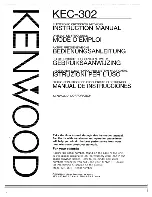
Manual-5
Setting the Output Level Controls
The INPUT LEVEL is an overall system sensitivity
adjustment. Use this control to decrease the overall sensitivity
of the entire sound system, including the mono subwoofer if
you are using one. You will generally want to start with this
control in the full clockwise (or “10”) position.
The LOW, MID, HIGH, and MONO SUB OUTPUT
LEVEL controls allow you to compensate for sensitivity
variations in amplifiers and drivers. Do not use these to adjust
overall system sensitivity unless you plan to re-align the
system afterward. With these set to the 0 dB mark and the
INPUT LEVEL set to 10, the crossover yields no level change
from input to output. This is the best gain structure and
provides the best signal-to-noise performance.
Crossover Philosophy
Now it gets real fun. The idea is to set the output LEVEL
controls on the crossover so that the entire speaker system has
a uniform, flat response. Unfortunately, the
room
in which
the speakers are placed has a habit of always getting into the
act, so things get messy. As a result there seems to be two
schools of thought regarding the use of active crossovers.
The Set-lt-Once-And-Glue-lt School
The philosophy here is to use the crossover to flatten
system response as much as possible
without
room acoustics
involved. This means setting up the system outside (unless
you happen to have a
very
large anechoic chamber handy)
and with the aid of a realtime analyzer and pink noise source,
adjust all of the crossover outputs so that the system is as flat
as possible. Once the system is tuned, the crossover is then
locked behind a security cover (posted guard is optional) and
never again touched. It is then the job of the system
equalizer(s)
to normalize or flatten the response for each
different room.
The Fix-lt-With-The-Crossover School
Here the crossover knobs get a good workout, for the
crossover is used at each location to help flatten the system
along with the equalizer.
Regardless of which school you profess, the absolute
importance and effectiveness of some kind of realtime
analyzer in your system cannot be overstressed! An analyzer
saves tremendous amounts of time and provides the absolute
consistency, accuracy, and plain old good sound that very few
ears on this earth can deliver. They are affordable, easy to use
and amazingly effective. You owe it to yourself and your
audience to at least look into one of today’s cost-effective
analyzers—you’ll wonder how you managed at all without
one.
OPERATING INSTRUCTIONS
Selecting Crossover Frequencies
Most speaker manufacturers supply low and/or high
frequency cut-off points for each driver, especially if these
are supplied in a system. These cut-off frequencies are based
on each driver’s performance, with a certain safety margin to
accommodate more gentle filter roll-offs.
The MX 23 utilizes 31-position precision DC control
voltage potentiometers to select the FREQUENCY points.
This crossover circuit design assures consistent accuracy from
Channel-to-Channel and unit-to-unit. This is a distinct
advantage over continuously variable designs using ganged
potentiometers which can yield large variations in channel-to-
channel matching. Even with 31 choices it is possible that the
exact recommended Crossover Frequency may not fall on one
of the detents on the selector. Not to panic, for drivers have
their own gradual rolloffs and tolerance variations. Just pick
the closest one. When in doubt, choose the higher Frequency
setting.
The illustrations and tables below detail the crossover
frequencies available on the detents that are not labeled. For
best overall system results, try to choose the speaker compo-
nents so that each operates well within its recommended
limits. This provides valuable leeway so that crossover points
may be adjusted in order to fine-tune the system. This also
yields higher system reliability. If at all possible, always use
some kind of realtime analyzer to tune your crossover, and
then fine-tune each system with an equalizer. Keep reading
for further alignment details.
STEP
0
1
2
3
4
5
6
7
8
9
10
11
12
13
14
15
16
17
18
19
20
21
22
23
24
25
26
27
28
29
30
LOW/MID
SCREEN
80
85
100
125
150
200
250
300
400
500
600
850
1000
LOW/MID
FREQ.
80
80
80
85
93
102 114 126 140 154 170 189 209
231 255 283 313 346 383 423 468 518
573 634 702
777
859
950 1000 1000 1000
MID/HI
SCREEN
350
420
600
750
1000
1500
2000
2500
3200
4000
5000
6500
7000
MID/HI
FREQ.
350 350 350
372 419
472 532 600 676
762 859 969 1092 1231 1388 1565 1765 1990 2242 2527 2850 3212 3621 4082 4602 5188 5848 6593 7000 7000 7000
Figure 1. See unmarked Frequency detent steps below.
Figure 2. Frequency detent table with actual frequencies of all detent steps.
















